I give many presentations and help a lot of Hams get started with FT8 and FT4. I often get asked, “Why am I having trouble making contacts?” and “What can I do to be more successful?”
Before we get started, please review the links to two definitive guides on WSJT-X and FT8:
Here are my top ten tips for succeeding in FT8:
- Time is Critical
- Proper Soundcard and Radio Configuration
- Picking your Transmit Frequency
- Three Little Checkboxes
- Band and Mode Choice
- Contests
- Helper Software
- Working DXpeditions and Other Rare Stations
- Understanding Special Operating Activity Options
Troubleshooting Checklist
The first two tips have to do with proper installation and configuration during the setup process to get started with FT8 and the underlying WSJT-X software.
Time is Critical: WSJT-X software requires close time synchronization of your computer. Typically, the built-in time synchronization in Microsoft Windows operating systems is not sufficient. Ideally, you will want less than 0.5 seconds of variation from time standards. I suggest one of two third-party tools:
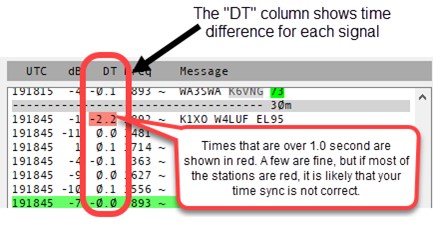
If you are operating in the field (for more than a day or two) or at a location with no Internet access, I suggest using a USB GPS Dongle to synchronize your computer’s clock.
Proper Soundcard and Radio Configuration: It is essential that your radio or interface soundcard is not set as the Windows default soundcard or that the wrong soundcard is chosen in WSJT-X. The most common problems occur when Windows does a software update, or you start WSJT-X software before your radio is turned on or USB cables are not plugged in. Depending on the model of radio you are using, you may need to make some changes to its settings. There are many guides to setting up specific model radios for WSJT-X on my website, the Internet, and YouTube. One thing to check is to make sure your bandwidth is set to its maximum setting.
If everything has been properly configured and your time is synched, the next important issue is choosing a transmit frequency to make sure other stations hear you.
Picking your Transmit Frequency: Unlike CW or SSB, where it is important to match your transmit frequency to the station you want to contact (unless, of course, a station is telling you that they are listening on a different frequency than they are transmitting on, a.k.a. split) FT8 and FT4 stations should not be called on their transmitting frequency. In fact, you want to make sure you are not using a frequency that anyone is transmitting on. With each station copying all of the signals in the passband, it does not matter where you call, so pick an open frequency where no one else is transmitting. You can use your mouse on the WSJT-X waterfall to select a spot to transmit by right-clicking or shift-left-clicking. See the screen capture below. The red bracket is where you want to be transmitting.

Three Little Checkboxes: Once you have chosen your transmit frequency, you do not want it changed to the frequency of the station you are trying to contact. You can avoid this by checking the box labeled “Hold Tx Freq.” Checking this box will ensure that the specified Tx frequency is not changed automatically when you double-click on decoded text or a signal in the waterfall. Two other boxes to check include “Auto Seq” to allow your station to automatically send the proper next transmission in sequence, and “Call 1st,” which enables automatic response to the first decoded responder when you are calling CQ.
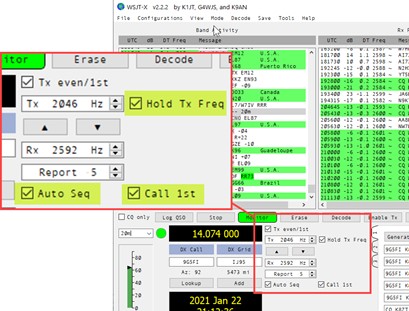
Band and Mode Choice: Just as with other modes, the choice of bands to use depends on several factors, including the current propagation situation, your available antennas, the area of the world you want to contact, etc. In addition to choosing a suitable band, you need to decide if you wish to use FT8 or FT4 since both cannot be operated simultaneously. FT8 activity can usually be found on any open band, but much newer FT4 activity is often only found during contests and on busier bands (e.g., 20 and 40 meters.) Hopefully, over time more operators will give the much faster FT4 a try on all bands.
Contests: Just as with other modes, there is usually a lot more activity during contest periods. Some bands such as 2 meters have infrequent FT8/FT4 contact opportunities on most days but can be fruitful on VHF contest days. Over the last few years, many contests have added FT8/FT4 as acceptable contacts, and there are even FT8/FT4 specific contests like the World Wide Digi DX Contest. Be aware that some contests require you to use a “Special Operating Activity option” to modify the way WSJT-X works (see below for details).
“Helper” Software: There are a few software programs and interactive websites that can assist you in making FT8 and FT4 contacts:
- JT Alert
(Windows)
- Provides Grid View of stations
- Can pull in name/location data from online callsign databases
- Keeps track of WAS, DXCC, CQZs, etc., on a band-by-band basis
- Sets Alarms for needed entities
- Enables upload of QSOs to several logging programs
- Lets you see band activity levels
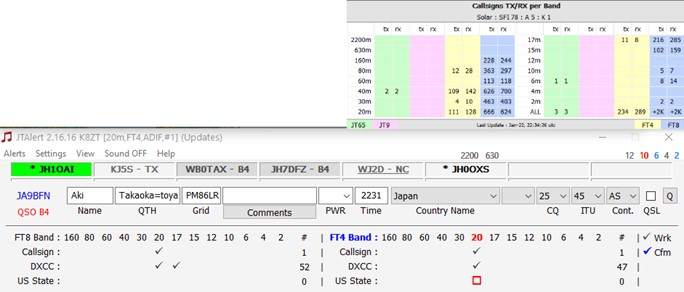
- AlarmetJT (Mac/Linux)
- Similar features to JTAlert but for Mac and Linux users
- PSK Reporter
- Online aggregator of on-air reception reports of digital stations
- Lets you see the stations that are receiving your signal and the strength of your signal there
- Lets you view real-time propagation results without even making a contact
- Can also be used to see results from another station’s location
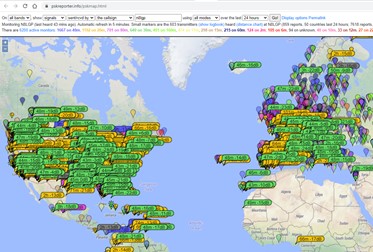
- HamSpots
- Another aggregator of digital Ham radio spots
- Provides information in tabular layout as opposed to a map layout
- AllText.exe
- Allows users to search through the All.txt file that is generated and updated by WSJT-X
Working DXpeditions and Other Rare Stations: To avoid the crowding that occurs when rarer DX appears, some DX and DXpedition stations will use two techniques to maximize the potential for QSOs.
- Use alternative frequencies outside the one’s predefined in WSJT-X. To work them, you will need to manually enter the frequency using the same drop-down selection box you normally use to change bands. Simply click in the box and use your keyboard to type in the desired frequency.
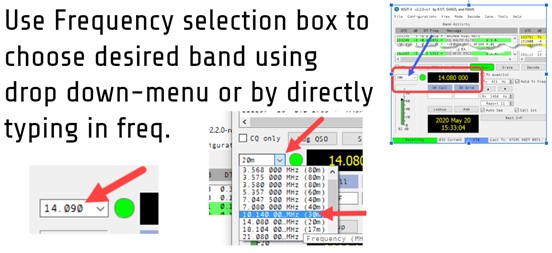
- How do you find the frequency? Just as with other DX, you can watch for online spots of activity, get a call or text from a buddy and/or follow lists of suggested frequencies on DXpedition websites.
- Many of these rare stations use a special operating activity option: Fox/Hound (see below for details).
Understanding Special Operating Activity options: These features change either the way WSJT-X works and/or change the usual transmission sequence messages. These options are under the Advanced tab of the Settings screen.
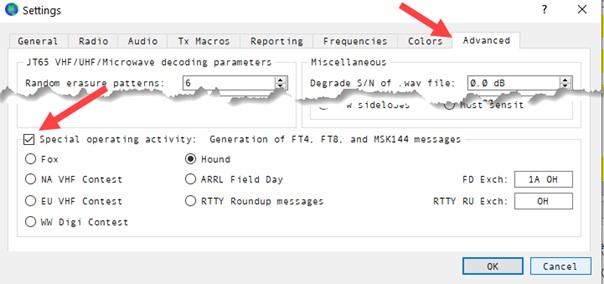
- First, check box “Special operating activity,” then specific type:
Fox and Hound Mode for working DX stations will restrict Fox to the bottom portion of the passband and have all Hounds transmitting above. It will also allow the Fox to respond to multiple Hounds at one time.
- Fox is for the DX station, not you, so do not use.
- Check Hound if you wish to make a QSO with such a Fox. Be sure to read the operating instructions for FT8 DXpedition Mode.
- The remainder of the choices change the way CQ is sent (CQ Test), and the exchanges sent depending on the contest. After choosing your contest, make sure the corresponding exchange is entered in the box for your location.
- Always remember to uncheck “Special operating activity” to return to normal operations.
Troubleshooting Checklist: The final tip is a series of items to check if the program is not decoding stations or you are not able to make contacts.
- Did you start WSJT-X software before turning on your radio?
- Are all connections between the radio, interface (if using one), and the computer connected properly?
- Have the Computer Soundcard settings been changed (especially after Windows updates)?
- Is Time Synchronization software operating?
- Have you lost your Internet connection (affects time sync)?
- Is your radio’s bandwidth filter set at maximum width?
- Is the radio in the correct mode (USB or Data, depending on your model)?
- Is WSJT-X in the correct mode (FT8 or FT4) and on the correct corresponding frequency for the band you are using?
- Are the three little boxes checked (Hold Tx Freq, Call 1st, Auto Seq)?
- Has a “Special Operating Activity” been selected?
- Are you decoding other stations, but no one is replying to you? Check PSK Reporter to see if stations are reporting that they are hearing your signal.
- Is your radio set to Split?
- Is radio working on other modes?
For more information, check out these other links regarding FT8/FT4: FT8 & FT4 Digital Soundcard Modes, Quick Start FT8/FT4 Operations, and OnAllBands blogs Can FT8 Be Used in the Field? and FT8: What Is it and How Can I Get Started?

